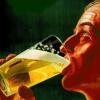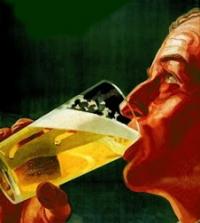
Clarity specifics: Chill haze...
#1

Posted 03 June 2014 - 08:43 AM
#2

Posted 03 June 2014 - 09:03 AM
Don't you use gelatin? Make sure the beer is colder than serving temp when you gel it and your haze should be gone.
#3

Posted 03 June 2014 - 09:25 AM
Yeah, good point. I do use gel on every batch but it's when the beer is room temp and on it's way to secondary. I did add some gel solution to a few beers after they were cold and I believe it did help but I think I may have been thinking that it was just a Band-Aid for some other part of my process that I wasn't doing right. My darker beers are almost always UBER-CLEAR and my pale beers are kind of hit and miss. I guess I attribute that to pH but now I'm hitting my pH numbers very nicely across the board so ALL the various colors should be clear. Adding gel to the cold, kegged pale beers should solve the issue and is easy enough to do. Cheers to bringing that idea back up.Don't you use gelatin? Make sure the beer is colder than serving temp when you gel it and your haze should be gone.
#4

Posted 03 June 2014 - 09:25 AM
If gelatin isn't doing it for you, you might also try PVPP (or Polyclar). The combination of these two is the nuclear option of clarifiers.
ETA: and yes, you should use gel when the beer is below 50°F.
#5

Posted 03 June 2014 - 09:28 AM
The chill haze won't come out with gelatin or any fining unless it's cold enough for the proteins to precipitate out and adhere to the gel.
#6

Posted 03 June 2014 - 09:30 AM
#7

Posted 03 June 2014 - 09:41 AM
are you still having issues since recent changes you've made to your sparge acidification process?
#8

Posted 03 June 2014 - 10:04 AM
Some of the beers coming up right now were made when my process was "getting there" but not perfect. For example, you may remember that BNW was suggesting more acid than I really needed and some of these beers on tap now probably had a mash pH under 5.0. Eventually I corrected that and made a number of beers where the mash pH was more in the 5.2 to 5.4 range. This latest batch of Kolsch was made during my "more confident" phase of mash, sparge and kettle pH. I assume the lower-than-desired pH could cause some cosmetic issues as well... good point.are you still having issues since recent changes you've made to your sparge acidification process?
#9

Posted 09 July 2014 - 01:38 PM
#10

Posted 09 July 2014 - 01:52 PM
Cold filtering I suspect. Also, I think reducing the tannin uptake will reduce chill haze formation. I'd have to look it up in a book to verify that.
Edited by SchwanzBrewer, 09 July 2014 - 01:53 PM.
#11

Posted 09 July 2014 - 01:54 PM
you probably have the pH thing pretty well under control which would reduce the tannins as rich mentioned.
I'm not sure if vigorous boil is a factor. There must be some literature with a list of chill haze sources. I mean - I know it's the grain but I'm talking sources in the process.
#12

Posted 09 July 2014 - 01:55 PM
#13

Posted 09 July 2014 - 01:55 PM
Good hot break, not getting hot break in the fermenter, proper PH, using lower protein malts...
#14

Posted 09 July 2014 - 02:36 PM
#15

Posted 09 July 2014 - 02:49 PM
Same here. For most of my recent batches, I have been adding 50-75 ppm calcium minimum even if it's not needed for pH reasons and my beers have been the clearest they've ever been. For this batch, I didn't want a minerally taste so I adjusted pH with lactic acid instead of adding calcium.Best Malz pils malt is very high in protein. That really applies to any continental pils malt. I use a lot of Best and MFB pils and for the next batch or two with those malts I'm going to throw in a protein rest at about 131°F to see if that helps.I wonder if boosting calcium would help fend off the haze. MTN, your description sounds like mine... cloudy as hell. But I know it's chill haze because it's beautiful if it warms up a bit.
#16

Posted 09 July 2014 - 02:52 PM
Same here. For most of my recent batches, I have been adding 50-75 ppm calcium minimum even if it's not needed for pH reasons and my beers have been the clearest they've ever been. For this batch, I didn't want a minerally taste so I adjusted pH with lactic acid instead of adding calcium.Best Malz pils malt is very high in protein. That really applies to any continental pils malt. I use a lot of Best and MFB pils and for the next batch or two with those malts I'm going to throw in a protein rest at about 131°F to see if that helps.
My N=1. I have made two batches of Helles in the last few months with Best Malz Pils and a single infusion mash. Both received 1/2t. gelatin in the keg after being chilled to 33-34F Neither had a hint of chill haze.
ETA: Should also add that both had 50ppm calcium and were fermented with WY2308 FWIW.
Edited by ettels4, 09 July 2014 - 02:56 PM.
#17

Posted 09 July 2014 - 03:29 PM
#18

Posted 09 July 2014 - 03:34 PM
I feel like I'm doing something wrong if I don't cold condition. In secondary if all possible on all beers. I just don't feel good about conditioning at room temps.
I remember Basser saying once that the beer should be conditioned as cold as you can possibly get it. The colder the better, obviously without freezing.
#19

Posted 09 July 2014 - 03:51 PM
Good hot break, not getting hot break in the fermenter, proper PH, using lower protein malts...
i've never skimmed hot break and as of late I've made pretty much zero attempt to avoid getting it into my fermentor. the non-wheat/oatmeal stuff has been nice clear beers (until I dry hop them ![]() ).
).
#20

Posted 09 July 2014 - 04:01 PM
0 user(s) are reading this topic
0 members, 0 guests, 0 anonymous users












